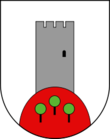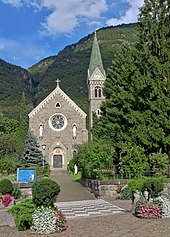Gargazon
| Gargazon | |
|---|---|
| (Italian: Gargazzone ) | |
| coat of arms | map |
| State : | Italy |
| Region : | Trentino-South Tyrol |
| Province : | Bolzano - South Tyrol |
| District community : | Burgrave Office |
|
Inhabitants : (VZ 2011 / 31.12.2019) |
1,666 / 1,751 |
|
Language groups : (according to 2011 census ) |
78.68% German 20.33% Italian 0.99% Ladin |
| Coordinates | 46 ° 35 ' N , 11 ° 12' E |
| Altitude : | 252– 440 m slm (center: 267 m slm ) |
| Surface: | 4.9 km² |
| Permanent settlement area: | 4.2 km² |
| Neighboring municipalities: | Burgstall , Lana , Mölten , Nals , Terlan , Tesimo |
| Postal code : | 39010 |
| Area code : | 0473 |
| ISTAT number: | 021035 |
| Tax number: | |
| Mayor (2015): | Armin Gorfer ( SVP ) |
Gargazon ([ ˈɡarɡatsoˑn ]; Italian : Gargazzone ) is an Italian municipality with 1751 inhabitants (as of December 31, 2019) in South Tyrol . It is 14 kilometers south of the spa town of Merano and 20 kilometers north of Bolzano , on the left side of the Adige Valley .
geography
The municipality of Gargazon is located in the Burggrafenamt in the Adige Valley between Merano and Bolzano . While the municipality covers areas on both sides of the Adige , the village lies on the orographic left , eastern side of the valley on the alluvial cone of the Aschler and Gargazon brooks . The center of the village is about 270 m above sea level; behind it, the terrain rises to the slopes of the Tschögglberg , which, however, only belong to the community in the vicinity of the valley up to a height of about 400 m .
The Aschler Bach forms the municipal boundary to Burgstall directly north of the village center . Even today, the Aschler Bach, which has several beautiful waterfalls , can be dangerous in storms . In 1960 and 1966, its water masses flooded the orchards in the valley floor and caused great damage.
history
The earliest written document is from 1027 and is "Garganzano fluvio". The word goes back to the Latin predial name Gargantius / Carcontius. However, these personal names are not really detectable. Another approach explains the place name with the Latin gargarizare (' gargle '). In connection with the fact that the earliest written testimony refers to a river ( fluvius ), the hypothesis of a stream with a gurgling noise would be quite conceivable. The name of the Aschler Bach is still today in the lower part of the Gargazon Bach. Aschl comes from Middle High German asche ('ash') and has therefore only been the name of the stream since the Middle Ages.
The Aschler Bach has served as an administrative border of regional or supraregional importance several times over the years:
- In the High Middle Ages it was probably the border between the counties of Vinschgau and Bolzano .
- As a result, at least until the late Middle Ages, it was the southern border of the burgrave office .
- With the Peace of Schönbrunn in 1809, the Aschler Bach formed the border between the Napoleonic kingdom of Italy and the Bavarian rule in Tyrol.
Gargazon belonged to the end of the First World War in the County of Tyrol for the judicial district of Merano and was part of the district of Merano .
Attractions
There are two churches in Gargazon; both are under monument protection.
Kurtialkirche to St. John the Baptist
A church in Gargazon is mentioned as early as 1337. It is the old church that now serves as a chapel for the dead. It has been rebuilt and restored many times, most recently in 1981. Now the church, built in Gothic style, is the jewel of the village. It has a 13.5 m high pointed tower, a multi-angled chorale end and a barrel vault. The altar is made of stucco marble; the altarpiece shows the baptism of Christ. The fir tree on the church premises is illuminated every year at Christmas time. The war memorial is located on the west side of the building. The annual St. John's Festival (June 24th) is also celebrated here.
Parish church
In 1899 the construction of a new church began in Gargazon, which was to be consecrated to the Sacred Heart , because the old one was so small that it was not even enough for half of the population at that time. The foundation stone was laid on May 13, 1900, and in 1902 the church was completed except for the superstructure of the tower. The mosaic picture above the main portal, Jesus Christ with his hands open, was inserted in December 1903. The church was only consecrated on May 13, 1928 by Bishop Celestino Endrici from Trento (May 13). The tower was completed in 1930 and the bells were consecrated in 1931. The building is in the Romanesque style. The porphyry stone, from which the whole church and the tower are built, comes from a nearby quarry. Because of this beautiful stone, external plastering was not necessary. The portals and cornices were made of sandstone and partly in yellow-gray Trento marble. Recently, new windows and colored panes have been installed, the door of the main portal has been copper-plated, a new sandstone altar has been erected, loudspeakers have been installed and heating has been installed.
Kröll Tower
The Kröll Tower was built by Berthold Chrello (first mentioned in 1237) from the Trautson family at Sprechenstein Castle , whose coat of arms symbol, the horseshoe open at the bottom, is located on the keystone of the Romanesque high entrance . The courtier of the Tyrolean Count Meinhard II probably built a small castle here in order to have a second residence near the royal castle of Tyrol ; he also owned most of the farms in Gargazon. It is, however, today only the dungeon and as yet no excavations have taken place, it is unclear whether on the side facing the valley west side also a small palace and a gatehouse stood. The possibility that it was a mere chalk tower as a watchtower and signal tower is considered unlikely for historical reasons. In the battles between Meinhard II and Prince-Bishop Heinrich II of Trient, Berthold Kröll must have sided with the latter, because in 1275 the count, along with many other noble castles, also conquered the Sprechenstein near Sterzing and the Kröll Tower. In 1279 Berthold was then in the service of the Carinthian Counts of Ortenburg .
In September 1905 a white farmer dug inside the tower and found seven Roman coins. An origin of the tower from Roman times is doubted. In 1984 a collapsed wall was rebuilt.
coat of arms
The coat of arms of Gargazon shows on a red-brown mountain, a reference to the reddish shimmering rock of the area, the Bozen quartz porphyry , in silver the keep Kröllturm. It was probably built by Berthold Chrello von Trautson in 1240. The three stylized deciduous trees indicate the vital fruit growing in the community.
Economy and tourism
Various apple varieties are grown in agriculture, most of which are marketed by the local fruit cooperative.
As a holiday resort, Gargazon is very popular in spring when it blooms, in summer for hiking and biking and in autumn at harvest time. Due to its central location, Gargazon is the starting point for countless excursions on foot or by bike, as well as for day trips by car or motorcycle (Dolomite tour, Lake Garda, Venice). The resort is a bit off the beaten track. The spa town of Merano and the provincial capital Bolzano can be reached within a few minutes by car, bus or train.
education
There is a German- and Italian-speaking kindergarten in Gargazon. In addition, a German-speaking elementary school. Further education takes place in the Terlan Middle School. The library has a large collection of books, magazines and other media. The inventory will continue to be built up and maintained.
politics
Mayor since 1952:
- Fridolin Thuile: 1952-1960
- Karl Adami: 1960–1968
- Johann Zischg: 1968–1974
- Rudolf Bertoldi: 1974-2010
- Armin Gorfer: since 2010
Important personalities
The most important personalities include:
- Father Josef Chronst (born March 19, 1924 in Gargazon, died December 17, 1997 in Lagundo) was pastor of the parish of Lagundo, dean of Tramin as well as cooperator and religious teacher in Schenna, Margreid and Nals, the builder of the new one during his priestly activity Parish church of Lagundo and honorary citizen of the village of Lagundo and holder of the State Cross of Merit of Tyrol.
panorama
literature
- Christoph Gufler: Gargazon - The village on the Adige . Gargazon 2018.
Web links
- Website of the municipality of Gargazon
- Landscape plan of the municipality of Gargazon . Office for Landscape Ecology, Autonomous Province of Bolzano - South Tyrol (PDF file)
- History of Tyrol: Gargazon
- Entry in the Tirol Atlas of the Institute for Geography at the University of Innsbruck
Individual evidence
- ↑ Christian Schneller: Contributions to local names in Tyrol. Reprint of the original. Verone, 2017, ISBN 978-9925-08277-3 , pp. 23 .
- ↑ Christoph Gufler is of the opinion that the Kröllturm was part of a small castle complex with a palas and gate: The Kröllturm in Gargazon , in: ARX. (Journal for) castles and palaces in Bavaria, Austria and South Tyrol, published by the South Tyrolean Castle Institute , Bozen, 2017, issue 2, pp. 24–28
- ↑ Gufler ibid.
- ↑ The mayors of the South Tyrolean municipalities since 1952. (PDF; 15 MB) In: Festschrift 50 Years of the South Tyrolean Association of Municipalities 1954–2004. Association of South Tyrolean municipalities, pp. 139–159 , accessed on November 16, 2015 .







